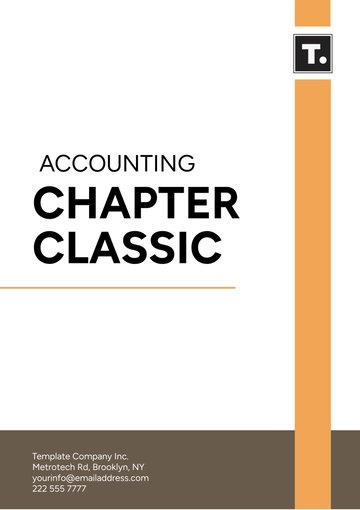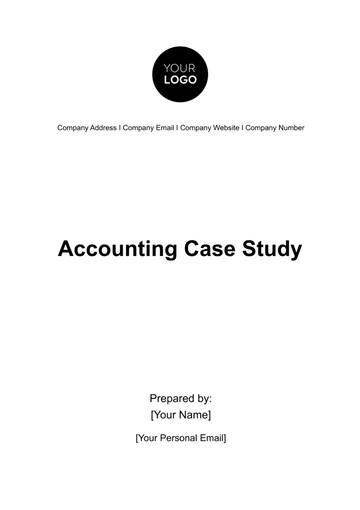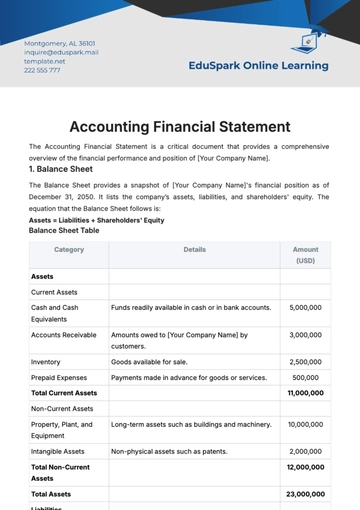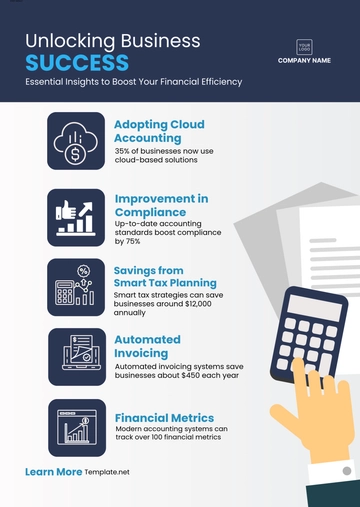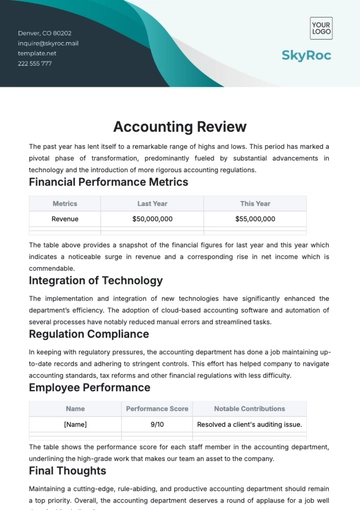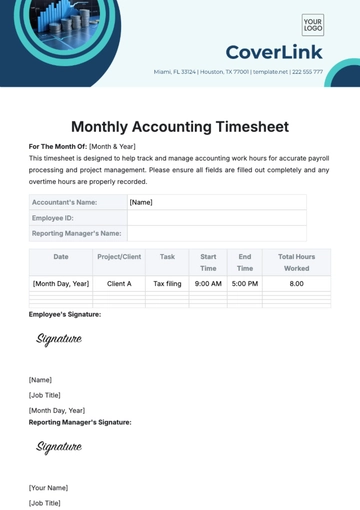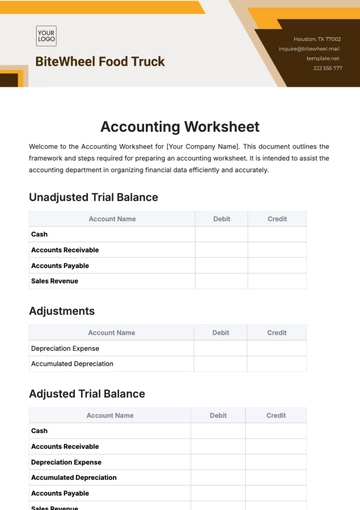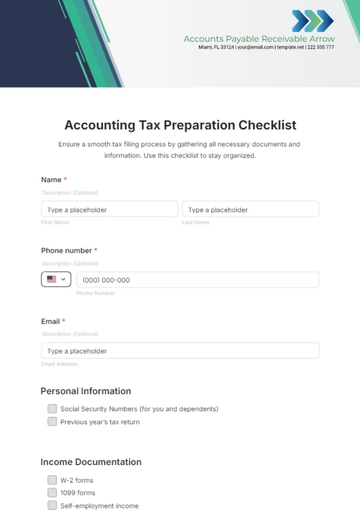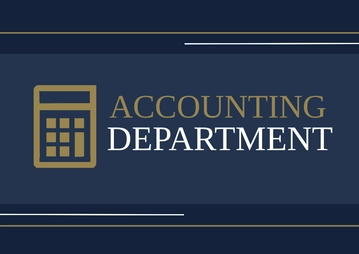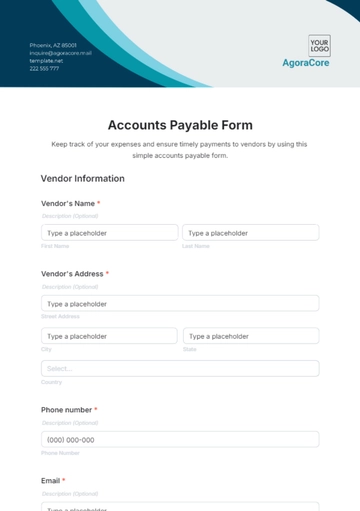Free Accounting Audit Protocol
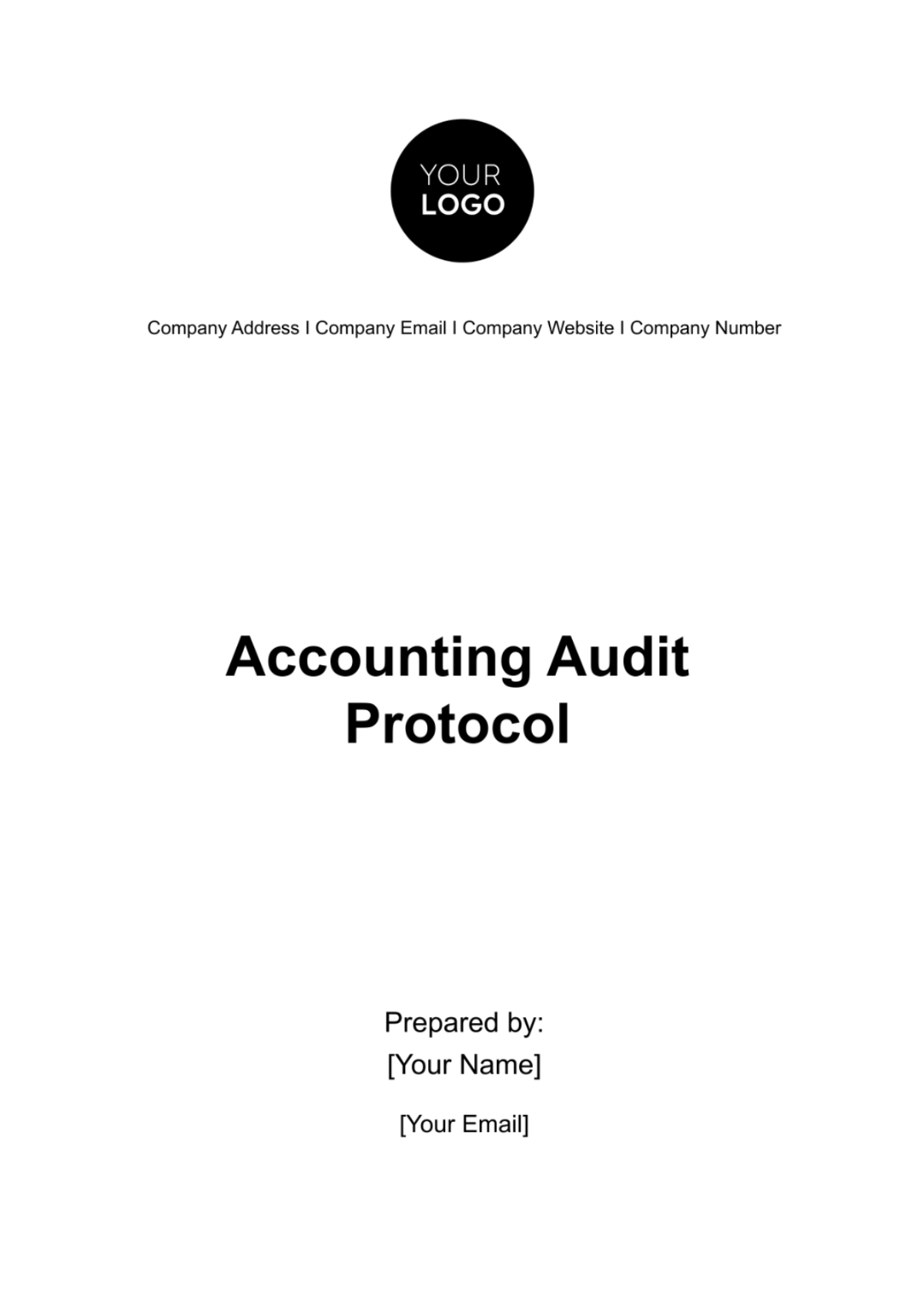
TABLE OF CONTENTS
Introduction..............................................................................................................3
Audit Planning..........................................................................................................5
Data Collection and Analysis..................................................................................6
Audit Testing............................................................................................................7
Audit Findings and Reporting.................................................................................8
Follow-up and Continuous Improvement...............................................................9
Conclusion.................................................................................................................10
Introduction
This protocol outlines the standardized procedures for conducting an accounting audit at [Your Company Name], effective from the year [2050] onwards. The aim is to ensure compliance with applicable financial regulations and internal policies, and to maintain accuracy and integrity in financial reporting.
Purpose and Importance of the Audit:
The primary purpose of the audit is to provide an independent and objective assessment of the financial statements of [Your Company Name]. This process is crucial for ensuring the accuracy and reliability of financial reporting, which is essential for maintaining investor confidence, complying with regulatory requirements, and supporting effective internal decision-making processes. The audit aims to identify any discrepancies or areas of risk in the financial records and to suggest necessary improvements or corrective actions.
Regulatory Compliance and Ethical Standards:
This audit protocol is designed to ensure full compliance with the latest accounting standards and regulatory requirements applicable in the industry. It emphasizes adherence to ethical principles, including integrity, objectivity, professional competence, confidentiality, and professional behavior. The protocol mandates that all auditing activities be conducted in a manner that upholds these principles and standards, thereby fostering a culture of transparency and accountability within [Your Company Name].
Audit Planning
The Audit Planning section of this protocol is foundational to the success of the auditing process at [Your Company Name]. It outlines the systematic approach and preparatory steps that will be taken to ensure a thorough and effective audit. This phase is critical for establishing a clear framework and guidelines that will govern the entire audit process, from initial risk assessment to final reporting. By planning the audit, we aim to achieve the highest levels of accuracy, compliance, and efficiency in our financial examination and reporting.
Audit Scope and Objectives:
The scope of the audit encompasses a thorough examination of all financial statements of [Your Company Name], including but not limited to the balance sheet, income statement, cash flow statement, and statements of shareholders' equity for the designated audit period, typically the fiscal year. The objectives are to verify the accuracy of these financial statements, ensure compliance with generally accepted accounting principles (GAAP) and applicable laws, and assess the effectiveness of internal financial controls.
Audit Team Composition and Qualifications:
The audit team will consist of a mix of internal auditors and external experts, each possessing specialized knowledge in accounting, finance, and [Your Company Name]'s industry sector. The team will be led by a Certified Public Accountant (CPA) with extensive experience in corporate audits. Team members are required to undertake continuous professional development to stay abreast of changes in accounting standards and regulations.
Risk Assessment and Materiality:
Prior to data collection, a risk assessment will be conducted to identify areas of high risk within [Your Company Name]'s financial operations. This involves evaluating the likelihood and impact of potential misstatements and focusing audit efforts where they matter most. Materiality thresholds will be set, determining the significance of financial misstatements or omissions that could influence the decision-making of users of the financial statements.
Timeline and Milestones:
A detailed audit timeline will be developed, delineating the various critical stages of the audit process, including planning, fieldwork, reporting, and follow-up. This timeline will not only list these phases but will also detail specific milestones and associated deadlines for each. By doing so, the timeline will serve as a guiding framework, ensuring that each phase of the audit progresses seamlessly and systematically. This structured approach is key to conducting the audit with the utmost efficiency and thoroughness, while also providing flexibility to adapt to unforeseen challenges.
Stakeholder Communication:
Effective and regular communication channels will be established and maintained with all key stakeholders throughout the duration of the audit process. These stakeholders include the management team of [Your Company Name], the audit committee, and relevant external regulators. The objective of this continuous dialogue is to uphold a standard of transparency and accountability. It also facilitates the prompt identification and resolution of any issues that may emerge during the audit, thereby fostering a collaborative and proactive audit environment.
Documentation and Record Keeping:
Robust documentation and meticulous record-keeping practices will be a cornerstone of the audit process. Every step, from the initial audit procedures to the final findings and communications, will be comprehensively documented. This extensive documentation serves multiple critical functions: it acts as a definitive record of the audit process, substantiates the conclusions drawn, and provides invaluable insights for future audits. Additionally, this documentation is essential for any potential regulatory reviews, ensuring that [Your Company Name] remains compliant and prepared for external scrutiny.
Data Collection and Analysis
In this phase, the audit team at [Your Company Name] will engage in a process of data collection and analysis. This crucial step involves gathering comprehensive financial information and applying various analytical methods to assess the company's financial health and compliance with accounting standards. The data collected will be scrutinized for accuracy, consistency, and transparency, forming the basis for informed audit conclusions.
Financial Data Gathering:
Collect comprehensive financial data, including but not limited to balance sheets, income statements, cash flow statements, and notes to financial statements for the audit period. This also involves gathering supporting documents such as invoices, bank statements, and transaction ledgers.
Total Assets | Total Liabilities | Total Equity | Net Income |
|---|---|---|---|
$500,000,000 | $300,000,000 | $200,000,000 | $50,000,000 |
Analytical Procedures
Perform analytical procedures on the collected data to identify trends, ratios, and variances that indicate potential financial issues or areas requiring further investigation.
Current Ratio | Debt-to-Equity Ratio | Gross Profit Margin | Return on Equity |
|---|---|---|---|
1.5 | 1.5 | 25% | 25% |
Internal Control Review
Evaluate the effectiveness of [Your Company Name]'s internal controls over financial reporting. This includes assessing control environment, risk assessment processes, control activities, information and communication systems, and monitoring controls.
Control Area | [2050] Evaluation | [2051] Evaluation | Notes |
|---|---|---|---|
Risk Assessment | Adequate | Improved | Noted increase in risk monitoring |
The data collection and analysis phase is a cornerstone of the audit process. It provides a detailed and objective view of [Your Company Name]'s financial activities, enabling the audit team to identify areas of concern and ensure the integrity of financial reporting.
Audit Testing
The Audit Testing phase is a critical component of the auditing process at [Your Company Name]. This stage involves a series of rigorous tests designed to validate the accuracy and reliability of the financial information gathered. Through these tests, the audit team aims to uncover any discrepancies, irregularities, or instances of non-compliance with accounting standards and regulatory requirements.
Substantive Testing
Perform substantive tests on a range of transactions and balances to confirm their validity. This includes testing for the existence, accuracy, completeness, authorization, and valuation of transactions and balances.
Test Category | Description | Results | Observations |
|---|---|---|---|
Existence | Verifying the existence of assets. | Satisfactory | Discrepancies in asset records. |
Compliance Testing
Assess the company's adherence to external regulatory requirements and internal policies. This involves reviewing procedures and transactions to ensure they are in line with relevant laws and standards.
Regulation / Policy | [2050] Compliance | [2051] Compliance | Notes |
|---|---|---|---|
GAAP Standards | Compliant | Compliant | Consistently met accounting standards. |
Risk Assessment and Mitigation
Continually reassess risks throughout the audit process. This involves identifying any new risks that emerge during testing and modifying the audit approach accordingly.
Risk Area | Initial Assessment | Final Assessment | Mitigation Measures Taken |
|---|---|---|---|
Credit Risk | Moderate | Low | Enhanced credit controls. |
Sampling and Extrapolation
Employ statistical sampling methods to select a representative subset of transactions for testing. Extrapolate the results of these tests to draw conclusions about the entire dataset.
Sample Type | Total Transactions | Error Rate | Conclusion |
|---|---|---|---|
Revenue Transactions | 10,000 | 2% | Acceptable error rate. |
Audit Testing at [Your Company Name] is designed to be thorough and adaptive, responding to the unique challenges and risks presented in each audit cycle. The results of this phase are integral in forming the basis of the audit report and recommendations.
Audit Findings and Reporting
The Audit Findings and Reporting phase is the culmination of the auditing process at [Your Company Name]. This stage is pivotal in synthesizing all the data, analyses, and testing outcomes into a coherent and comprehensive audit report. This report provides crucial insights and recommendations for improvements. Transparency, accuracy, and clarity are paramount in this phase to ensure that all stakeholders have a clear understanding of the audit results and the financial health of the company.
Drafting the Audit Report:
This report serves as a comprehensive document that encapsulates the essence of the audit findings. It begins with an executive summary, providing a high-level overview of the audit outcomes, and is followed by an in-depth analysis of the findings. These are systematically categorized into critical issues, significant deficiencies, and actionable recommendations. The report also includes a nuanced auditor's opinion on the financial statements, reflecting the depth and breadth of the audit conducted.
Management Review and Response:
Upon the completion of the draft report, it is presented to the management of [Your Company Name] for a thorough review. This step is vital in ensuring a collaborative approach to the audit process. Management is encouraged to offer responses, clarifications, and perspectives on the findings, especially on any identified issues or deficiencies. Their input is invaluable and is integrated into the final report, ensuring a balanced and comprehensive representation of the audit findings.
Finalizing the Audit Report:
The finalization of the audit report is a critical step. It involves the assimilation of management’s responses and any additional insights from the final stages of the review. The auditor's opinion, a key element of the report, is formulated based on the completeness and accuracy of the financial statements and can range from an unqualified opinion to a disclaimer, reflecting the audit’s thoroughness and integrity.
Communication and Distribution:
Effective communication and distribution of the finalized audit report are paramount. This report is disseminated to key stakeholders such as the audit committee, the board of directors, investors, and relevant regulatory bodies. The communication strategy is crafted to ensure clarity and comprehension, emphasizing the significance of the audit findings and the auditor’s opinion.
Post-Audit Meeting:
A post-audit meeting is convened with [Your Company Name]'s management and audit committee. This meeting serves as a platform to delve into the audit findings, address any areas of concern, and strategize the implementation of the recommendations. This interactive session is crucial for establishing mutual understanding and agreement on future actions and enhancements.
Public Disclosure:
In compliance with legal mandates and company policies, [Your Company Name] may engage in the public disclosure of significant audit findings. This step is particularly crucial when the findings have a substantial impact on the company’s financial statements or its compliance posture. Such transparency is key to maintaining stakeholder confidence and regulatory compliance.
Feedback and Improvement:
Finally, the protocol emphasizes the importance of feedback and improvement. Feedback is solicited from all parties involved in the audit process - the audit team, management, and other stakeholders. This feedback is instrumental in refining future audits, fostering a culture of continuous improvement, and ensuring adaptability to evolving financial landscapes and regulatory requirements.
The Audit Findings and Reporting phase is integral in closing the loop of the audit cycle at [Your Company Name], providing a clear and actionable view of the company’s financial position and paving the way for enhancements in financial practices and controls.
Follow-up and Continuous Improvement
The Follow-up and Continuous Improvement phase is an essential component of the audit cycle at [Your Company Name]. This stage ensures that the insights and recommendations derived from the audit are actively implemented and tracked for effectiveness.
Implementation of Audit Recommendations:
Crafting a comprehensive action plan to address the audit recommendations is a pivotal step. This plan should delineate specific, actionable tasks, assign them to designated individuals or departments, and establish clear timelines and expected outcomes for each task. It is imperative for management at [Your Company Name] to actively engage in and take ownership of this implementation process, as this commitment is crucial for the effective resolution of the identified issues and for driving meaningful change within the organization.
Monitoring and Reporting on Implementation:
A robust monitoring mechanism will be established to diligently track the progress of implementing the audit recommendations. This mechanism will involve periodic updates - either on a quarterly basis or more frequently for critical issues - to the audit committee and senior management. Such consistent reporting is essential to ensure transparency and to maintain the momentum of the implementation process.
Assessment of Implemented Changes:
Post-implementation, a thorough assessment will be conducted to evaluate the effectiveness of the changes made. This evaluation can be integrated into the subsequent audit cycle or executed as an independent review. The primary focus will be to ascertain whether the implemented changes have effectively addressed the identified issues and to gauge their impact on the overall financial control environment of [Your Company Name].
Feedback Loop and Continuous Learning:
Establishing a dynamic feedback loop is crucial for continuous improvement. This loop will involve the audit team, management, and other stakeholders, enabling an exchange of perspectives on both the audit process and the efficacy of the implementation of its recommendations. Insights gained from this feedback will be instrumental in the continuous refinement of audit practices and the enhancement of financial controls.
Updating Audit Methodologies and Tools:
In response to the audit findings and accumulated feedback, there will be a concerted effort to update and refine the audit methodologies and tools. This update will take into account emerging risks, evolving accounting standards, and technological advancements, ensuring that the audit process remains cutting-edge, efficient, and fully capable of addressing contemporary challenges.
Training and Development:
Ongoing training and professional development will be a cornerstone for the audit team and relevant staff members at [Your Company Name]. This training will encompass the latest developments in accounting standards, advanced audit techniques, and any pertinent changes in regulatory requirements, ensuring that the team remains proficient and well-equipped to handle the complexities of modern financial auditing.
Annual Audit Process Review:
An annual review of the audit process will be conducted to critically assess its efficiency and effectiveness. This review is intended to identify areas for improvement, streamline the audit process, and implement necessary adjustments in preparation for the next audit cycle. This ongoing review and refinement process is essential for maintaining the high standards of auditing at [Your Company Name] and for fostering a culture of excellence and adaptability in our audit practices.
The Follow-up and Continuous Improvement phase at [Your Company Name] is about turning insights into action and fostering an environment of perpetual advancement in financial reporting and control processes. It underscores the company's commitment to upholding the highest standards of financial integrity and responsiveness to change.
Conclusion
The Accounting Audit Protocol for [Your Company Name] represents a comprehensive and structured approach to financial auditing. The protocol underscores our commitment to financial integrity, transparency, and continuous improvement. By adhering to these guidelines, [Your Company Name] is dedicated to maintaining the highest standards of financial accountability and fostering trust among stakeholders.
- 100% Customizable, free editor
- Access 1 Million+ Templates, photo’s & graphics
- Download or share as a template
- Click and replace photos, graphics, text, backgrounds
- Resize, crop, AI write & more
- Access advanced editor
Amplify your auditing efficiency with Template.net's Accounting Audit Protocol Template. It’s fully customizable and editable with our Ai Editor Tool, allowing for seamless adaptations to your requisites. Armed with professional-quality content, switch to our intuitive user-friendly templates that help maintain financial transparency, assuring you unmatched precision. Leverage the power of customization now and redefine your auditing process.





